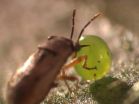Study advances understanding of volcanic eruptions
Scale of eruptions appears to hinge on first 10 seconds of bubble growth in magma
2012-10-16
(Press-News.org) Volcanic eruptions vary from common, small eruptions that have little impact on humans and the environment to rare, large-to-gigantic eruptions so massive they can threaten civilizations.
While scientists don't yet fully understand the mechanisms that control whether an eruption is large or small, they do know that eruptions are driven by the rapid expansion of bubbles formed from water and other volatile substances trapped in molten rock as it rises beneath a volcano. The mechanism is much the same as that involved in shaking a bottle of a carbonated drink and then opening the lid. Whether the volcano or the drink erupts dramatically or slowly loses its gas depends on the interplay of bubble growth and gas loss. Investigating the formation and growth of bubbles and their effects on magma properties thus provides a key to understanding volcanic eruptions, and could lead to better predictions of their scale.
An international research team led by Prof. Don R. Baker of McGill University's Department of Earth and Planetary Sciences has published a new study in Nature Communications that suggests the difference between a small or large eruption depends on the first 10 seconds of bubble growth in molten rocks. The findings point to a need to develop volcanic monitoring systems that can measure rapid changes in gas flux and composition during those brief, crucial moments.
The researchers examined the growth of volcanic bubbles in real time by heating water-bearing molten rock with a recently developed laser heating system at the Swiss Light Source facility in Villigen, Switzerland, where they could perform three-dimensional X-ray microtomography (CAT scans) of the samples during the first 18 seconds of bubble growth and foaming. With these images, the researchers were able to measure the number and size of bubbles, investigate the geometry of the connections between bubbles, and calculate how quickly gas flowed out of the sample and how the foam strength dropped.
The researchers found that initially thousands of small bubbles per cubic centimetre formed, trapping gas inside them, but that they swiftly coalesced into a foam of larger bubbles whose strength rapidly decreased while the rate of gas loss increased. All of these changes occurred within the first 15 seconds of bubble growth. They then determined which conditions of bubble formation and growth lead to failure in the rock.
From these results, Baker and his team hypothesized that even molten rocks with small amounts of water have the potential to create devastating, large eruptions. In most cases gas escapes rapidly enough to outpace bubble growth, resulting in smaller eruptions; but under exceptional rates of bubble expansion, or conditions where the bubbles cannot coalesce, large eruptions may result.
The findings represent a small but important step toward the goal of being able to predict the type of eruption that will occur in various volcanic regions of the world. "Future work will need to concentrate on the first few seconds of bubble growth and the effect of crystals on the bubble growth," Baker said.
INFORMATION:
Co-authors of the study are Francesco Brun, of Universita' degli Studi di Trieste in Italy; Lucia Mancini of Elettra - Sincrotrone Trieste; Cedrick O'Shaughnessy, a former McGill master's student; Julie L. Fife of the Swiss Light Source at the Paul Scherrer Institut; and Mark Rivers of the University of Chicago.
Funding for the study was provided by the Natural Sciences and Engineering Research Council of Canada and the Swiss Light Source.
END
ELSE PRESS RELEASES FROM THIS DATE:
2012-10-16
Tampa, FL (Oct. 16, 2012) -- A landmark paper identifying genetic signatures that predict which patients will respond to a life-saving drug for treating congestive heart failure has been published by a research team co-led by Stephen B. Liggett, MD, of the University of South Florida.
The study, drawing upon a randomized placebo-controlled trial for the beta blocker bucindolol, apprears this month in the online international journal PLoS ONE. In addition to Dr. Liggett, whose laboratory discovered and characterized the two genetic variations, Christopher O'Connor, ...
2012-10-16
This press release is available in German.
To solve the acute, global problem of securing food resources for a continuously growing population, we must work constantly to increase the sustainability and effectiveness of modern agricultural techniques. These efforts depend on new insights from plant ecology, particularly from work on native plants that grow in the primordial agricultural niche. Based on field studies on wild tobacco plants in the Great Basin Desert, Utah, USA, researchers of the Max Planck Institute for Chemical Ecology in Jena, Germany, demonstrated that ...
2012-10-16
An extremely brief reversal of the geomagnetic field, climate variability and a super volcano
41,000 years ago, a complete and rapid reversal of the geomagnetic field occured. Magnetic studies of the GFZ German Research Centre for Geosciences on sediment cores from the Black Sea show that during this period, during the last ice age, a compass at the Black Sea would have pointed to the south instead of north. Moreover, data obtained by the research team formed around GFZ researchers Dr. Norbert Nowaczyk and Prof. Helge Arz, together with additional data from other studies ...
2012-10-16
People in creative professions are treated more often for mental illness than the general population, there being a particularly salient connection between writing and schizophrenia. This according to researchers at Karolinska Institutet in Sweden, whose large-scale registry study is the most comprehensive ever in its field.
Last year, the team showed that artists and scientists were more common amongst families where bipolar disorder and schizophrenia is present, compared to the population at large. They subsequently expanded their study to many more psychiatric diagnoses ...
2012-10-16
While studying Parkinson's disease, an international research group made a discovery which can improve industrial protein synthesis for therapeutic use. They managed to understand a novel function of non-protein coding RNA: the protein synthesis activity of coding genes can be enhanced by the activity of the non-coding one called "antisense."
To synthesize proteins, the DNA needs RNA molecules serving as short "transcriptions" of the genetic information. The set of all these RNA molecules is called "transcriptome." In the human transcriptome, along with around 25 thousand ...
2012-10-16
Evolution has not only controlled human development over millions of years, it also has an impact on modern man. This is one of the conclusions of a study of Argentinian villagers in the Andes, where the water contains high levels of arsenic. A gene variant that produces efficient and less toxic metabolism of arsenic in the body was much more common among the villagers than among other indigenous groups in South or Central America. The study was a collaborative effort by Karin Broberg from Lund University and Carina Schlebusch and Mattias Jakobsson from Uppsala University ...
2012-10-16
Astronomers using the NASA/ESA Hubble Space Telescope have studied a giant filament of dark matter in 3D for the first time. Extending 60 million light-years from one of the most massive galaxy clusters known, the filament is part of the cosmic web that constitutes the large-scale structure of the Universe, and is a leftover of the very first moments after the Big Bang. If the high mass measured for the filament is representative of the rest of the Universe, then these structures may contain more than half of all the mass in the Universe.
The theory of the Big Bang predicts ...
2012-10-16
Dusty plasmas can be found in many places both in space and in the laboratory. Due to their special properties, dust acoustic waves can propagate inside these plasmas like sound waves in air, and can be studied with the naked eye or with standard video cameras. The RUB physicists Prof. Dr. Dr. h.c. Padma Kant Shukla and Dr. Bengt Eliasson from the Faculty of Physics and Astronomy have published a model with which they describe how large amplitude dust acoustic waves in dusty plasmas behave. The researchers report their new findings in the journal Physical Review E.
Different ...
2012-10-16
OTTAWA, October 16, 2012 – Few drugs are available to treat muscle injury, muscle wasting and genetic disorders causing muscle degeneration, such as Duchenne muscular dystrophy. A compelling discovery that may change this was made recently by a research group led by Dr. Robert Korneluk, distinguished professor at University of Ottawa's Faculty of Medicine and founder of the CHEO Research Institute's Apoptosis Research Centre, was reported today in Science Signaling.
"We know of five pharmaceutical companies pursuing phase one clinical trials with specific drugs to treat ...
2012-10-16
Research from North Carolina State University on flower production and disease resistance in watermelon varieties should help bolster seedless watermelon harvests for farmers.
Seedless watermelons are more popular than seeded watermelons, making them a more profitable crop for farmers. But the flowers of seedless watermelon plants must be fertilized with pollen from the male flowers of seeded watermelon plants, because seedless plants do not produce genetically viable pollen.
This is a problem, because seeded watermelon plants take up space, nutrients and water that ...
LAST 30 PRESS RELEASES:
[Press-News.org] Study advances understanding of volcanic eruptions
Scale of eruptions appears to hinge on first 10 seconds of bubble growth in magma



